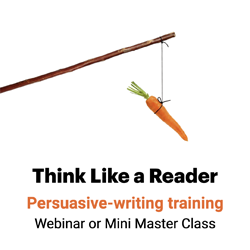‘Make ’em sick, make ’em well’ & 6 other ways to move people to act
Start with the problem.

Communicators are often too eager to rush in with the solution — the product, service or idea. After all, that’s what we’re selling. But one powerful persuasive technique invites writers to focus on the problem first.
“When you advertise fire extinguishers, open with the flames.”
— David Ogilvy, ad man
Call it “make ’em sick, make ’em well”: Persuade people by first showing your audience members how bad life can get without your product, service or idea. Here’s how it works in a financial services campaign:
| Make ’em sick | Make ’em well |
| If you’re an individual trustee managing trust assets on your own — even if you’re working with a professional investment adviser — you are personally responsible to the trust for the performance of its assets. | To protect yourself against a lawsuit and possible damages for poor performance, turn to ABC’s XYZ service. |
“When you advertise fire extinguishers, open with the flames,” counseled ad man David Ogilvy. Remember: Fire first, fire extinguisher second.
Here are 6 more writing techniques for bringing people around to your point of view:
1. Reframe statistics for persuasion.
Which is more dangerous? A disease that kills 1,286 out of every 10,000 people it strikes? Or one that kills 12.86% of its victims?
The former is about 20% more dangerous, said a group of college students, according to Paul Slivic, University of Oregon psychologist. In fact, 1,286 out of 10,000 is just a different expression of 12.86%.
“If you tell someone that something will happen to one out of 10 people,” Slivic told Money, “they think, ‘Well, who’s the one?’”
Writing to persuade? To make statistics more compelling, make them more emotional. When writing about people, use whole numbers instead of percentages.
2. Narrow their options.
- Would you rather meet on Thursday or Friday?
- Would you like the premium or the deluxe model?
- Do you prefer package A, B or C?
The best persuasive writers frame their messages to include a limited number of options. That way, the communicator, and not the audience member, selects the options. “A or B,” for example, reframes the usual buying decision from “yes or no” to “this or that.”
Limit options to a handful: In one study, researcher Sheena Iyengar set up a tasting booth of gourmet jams. When six flavors were offered, 30% of folks who stopped by the booth bought some jam. When there were 24 options, only 3% made a purchase.
Too many options can paralyze readers. Don’t cause your audience members to opt out altogether. To persuade people, offer this or that.
3. Have a great IDEA.
Whether you’re selling products, services or your company’s new casual dress program, you’ll want to start with getting your readers’ attention and close with a call to action.
This IDEA approach is a great persuasive writing technique:
- Start with an interesting fact, anecdote or quote to get audience attention.
- Make your defining statement, your key message point.
- Use examples to illustrate and support your message.
- Request their immediate action. Let readers know what to do with the information you’ve given them.
4. Don’t We-we on your readers.
To make sure you’re writing to persuade readers — and not about your own organization and its stuff — try John Sweeney’s N-I-C model. Write persuasive copy that focuses on the readers’:
- Need. What “go and do” information do they need? Contact information, URLs, maps? Those become your calls to action.
- Interest. What information do these particular readers want? Consider their demographics and psychographics. Are they mostly .coms, .orgs or .edus?
- Curiosity. Human interest, narrative drama, suspense and other creative elements appeal to all readers and make even the most boring topics more interesting.
5. Think ‘who’ and ‘ooh.’
Michael Sheehan has coached more presidents, vice presidents, cabinet secretaries, governors and members of Congress than anyone in the country. Here’s his two-step approach to helping these power brokers frame their messages:
- Ask “who?” Who’s your target audience? Who will be reading, watching or listening to this message?
- Ask “ooh?” What can you do to make them say, “Ooh, that’s interesting!”
6. Pull the trigger.
When my bookkeeper asked me recently to bring a bag full of business documents over, I put the bag on the bench by my front door so I’d see it on my way out. After forgetting the bag twice, I laced my purse straps through the bag handles. The act of untangling my purse finally reminded me to carry the bag to the car.
That’s called an environmental trigger — a visual cue in the right place to remind you to act in a certain way. You use environmental triggers all the time:
- That’s why your vitamins are on the shelf in front of your cereal box.
- It’s why your take-at-bedtime prescription is on your bedside table next to your reading glasses.
- It’s why the first thing I see when I open my refrigerator is a party-sized tray of crudités from Costco. (Which, sadly, doesn’t keep me from reaching around the tray to grab the sour cream dip.)
Environmental triggers move you to act. You can also use them to move audience members to act.
AT&T’s used a persuasive trigger for its “It Can Wait” pledge:
Take out your phone right now and look at the last text message you got. Read it out loud. Is that text worth causing an accident?
Texting and driving, it can wait. Please take the pledge not to text while driving. …
Why not “Think of the last text message you got?” Because your phone’s the trigger. Next time you pull it out while you’re behind the wheel, AT&T communicators hope, you’ll think “It can wait.”
What persuasive writing techniques do you use to bring readers around to your point of view? Please share in the comments section below.

Leave a Reply